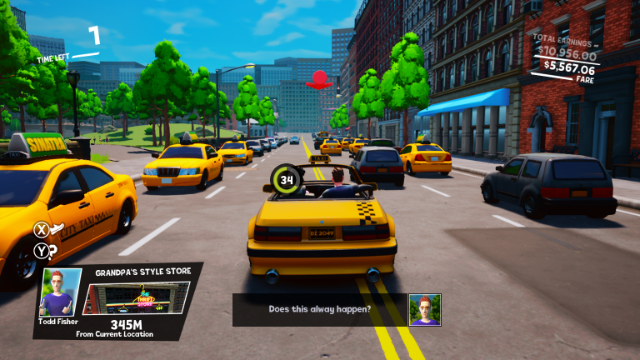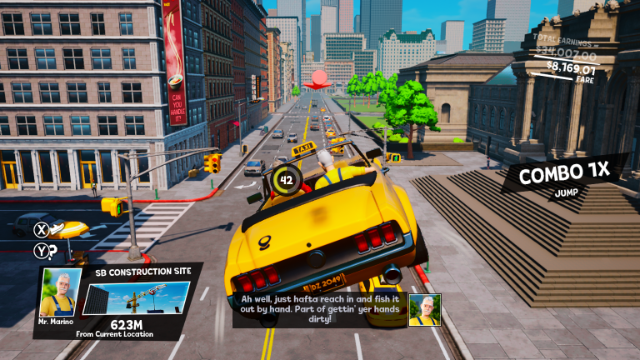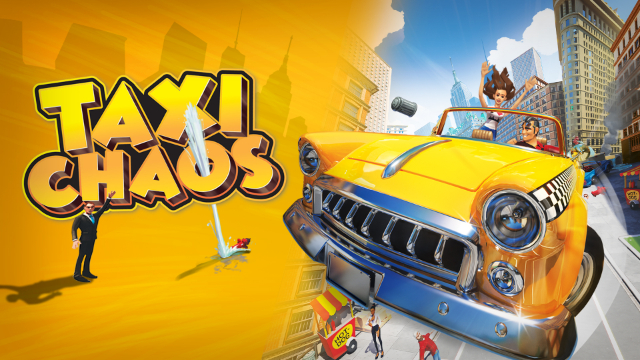One of the Dreamcast’s most pivotal games was Sega’s own arcade port of Crazy Taxi. The ridiculously entertaining driving game, where players take the role of a taxi driver in a very-San Francisco-like city, is one of the few games nearly everyone wanted to play. It didn’t matter if they were devoted players or people who never picked up a control pad, Crazy Taxi’s allure was unstoppable.
There was a sequel, and the game has been ported to newer systems over the years, but Crazy Taxi has largely fallen into nostalgic obscurity. Since it was a coin-op game first, it focuses on tight time limits where players must race to pick up and deliver as many passengers as possible. The licensed Green Day tracks add to the punky fun, and the arcade driving physics are infectiously hilarious. It is an easy game to pass around and low-key compete over.
Taxi Chaos is a blatant attempt to rekindle the magic of Crazy Taxi and, for the most part, it does an admirable job of recreating that old arcade experience.
Taxi Chaos Review: Way Past Time to Make Some Crazy Money
In Taxi Chaos, you choose from one of two cabbies, select your car, and go off to pick up fares. In the age of Uber, a taxi driving game has a funny appeal, but there’s no realism anywhere to throw off the nostalgic vibes.
The driving physics are purely old-school, where the car handles absurdly well, can steer in the air, and just generally fails to follow any fun-breaking laws of nature. This isn’t a driving sim, after all.
The game’s location, New Yellow City, is inspired by New York City. It’s just large enough to have multiple differently-themed areas and scenery, with ample landmarks to make getting around natural. In the arcade and free-roaming modes, you have a GPS arrow to guide you. The unlockable Pro mode ditches any guide and requires players to just know their way around.
There are some minor variations on the original Crazy Taxi here. For one thing, your car has a jump button, which helps it leap out of traffic jams and over obstacles provided you have enough speed. While there are only two cabbies (Crazy Taxi offered four distinct personalities), there are seven different cars to unlock. New cabs are accessible after accomplishing specific achievements, like getting a four- or five-star delivery ranking in different game modes.
Each car has different specs and, therefore, at least slightly different handling and speed characteristics. Speed is especially important for the main arcade mode, where you have 90 seconds to pick up and deliver as many fares as possible as quickly as possible. Pro and free roam are unlocked easily after a few rounds of the arcade mode.
There are special fares with more dialogue and a lot of the comments are pretty amusing. These customers introduce a kind of egg hunt across the entire world. They’ll mention an item they need (protein bars, whoopie cushions, etc.), and you can find these hidden throughout the city. Getting enough of them unlocks a special cab.

Taxi Chaos captures the absurd, frenetic pacing and style of Crazy Taxi well overall, but it’s definitely not without its share of hiccups.
New Yellow City is entertaining, but one of the great joys of the original game is leaping over its insanely monster hills. Adding a jump button tries to compensate for the lack of such extreme road contours here, but it doesn’t lead to the same sense of exhilaration.
The game also has a lot of redundancies. It overuses the same bits of dialogue (even among different speakers) and uses the same handful of destinations way too much. Even with the addition of special fares, it doesn’t take long before you’ve seen the bulk of what Taxi Chaos‘ world has to offer.
Another issue is the lack of customization. Unlike the game it’s inspired by, Taxi Chaos doesn’t let you configure the arcade mode options, such as increasing the time limit. There’s no multiplayer at all, and the free roam mode doesn’t offer any different or more interesting elements and objectives over arcade or pro mode.
Crazy Taxi offers an admittedly limited, coin-op-centric experience, but replicating that concept 20 years later with almost no changes really enunciates the game’s core shallowness. Taxi Chaoseven looks retro with its lower-poly 3D graphics.
Taxi Chaos Review — The Bottom Line

Pros
- It’s as close to an actual return of Crazy Taxi that we’re likely to get
- Nice variety of cars, fun location
- Three modes and absurd arcade driving physics
Cons
- Overuse of dialogue and distant destinations
- Not enough customization options and modes
- No multiplayer
Taxi Chaos is a fun reminder why Crazy Taxi is so great, but also why we probably haven’t seen the series return. Had the game been more expansive, with greater variety and other modern amenities, this homage could have surpassed the original.
As it is, it’s worth playing, but it definitely doesn’t shine as brightly as Sega’s original.
[Note: Lion Castle Entertainment provided the copy of Taxi Chaos used for this review.]







Published: Feb 28, 2021 06:57 pm